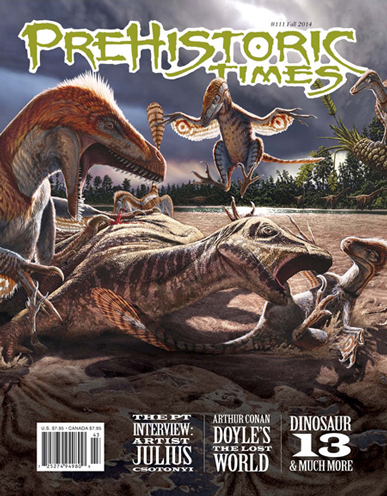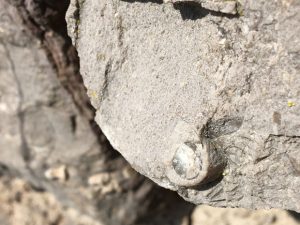A Review of Prehistoric Times (Issue 111) Autumn 2014
Summer may be over for us in the Northern Hemisphere and for the UK the clocks go back next week heralding some months when nights are going to be longer than days. However, perfect fireside reading has arrived in the nick of time, in the shape of the latest edition of the quarterly magazine “Prehistoric Times” and once again it is jam packed with interesting articles, fantastic artwork and features.
“Prehistoric Times”
Decorating the front cover is a beautiful rendering of a Cretaceous fight scene between an unfortunate Hippodraco (iguanodontid) and a mob of Utahraptors. This artwork was created by the very talented Julius Csotonyi and inside this issue there is a super interview with the palaeo-artist and a review of his new book “The Palaeoart of Julius Csotonyi” by Julius and Steve White. Everything Dinosaur team members were sent a copy of this hardback a few months ago, it really is an excellent book showcasing the talents of a remarkable artist.
Julius Csotonyi Interviewed
The interview with Julius conducted by “Prehistoric Times’s” editor Mike Fredericks, is supported by lots of illustrations which show the range of prehistoric animals and time periods covered by Julius in his new publication. The scene featuring several Late Cretaceous herbivores demonstrating “dietary niche partitioning” is my personal favourite, although my nephew likes the eyeball-plucking raptor best – still that’s kids for you.
The Front Cover Artwork (Prehistoric Times Issue 111)

Prehistoric Times magazine.
Picture credit: Prehistoric Times
Baryonyx Featured
One of the featured prehistoric animals is Baryonyx and there are oodles (scientific term), of great illustrations sent in by readers on this member of the Spinosauridae and we greatly appreciated the article by Phil Hore on this theropod. We too, like Phil, have speculated on how many fossil specimens ascribed to prehistoric crocodiles in the past may well turn out to be evidence of widely dispersed spinosaurids. Special mention to our chum Fabio Pastori for a simply stunning Baryonyx drawing.
The magazine has a bit of an “English theme” running through it. Dinosaur discoveries of southern England are documented in another article, which features the artwork of John Sibbick and there is a well written piece by John Lavas that discusses the impact of Sir Arthur Conan Doyle’s “Lost World”, a novel that we are informed has not been out of print since its publication back in 1912. Bringing things right up to date, our review of “Dinosaurs of the British Isles” is featured, a book which documents and catalogues the Dinosauria known from these shores.
How to Draw Dinosaurs with Tracy Lee Ford
Tracy Lee Ford continues his series on how to draw dinosaurs by discussing integumental coverings – feathers, quills and bristles on the Dinosauria. He makes some excellent points and it is great to see a piece that features one of our favourite dinosaur discoveries of recent times, Kulindadromeus zabaikalicus. This little feathered, plant-eating dinosaur makes another appearance in the Palaeo News section, along with updates on the Spinosaurus quadruped/bidped debate, giant prehistoric birds, a newly described Archaeopteryx specimen and a short report on Dreadnoughtus schrani . Dreadnoughtus is important as a large number of bones have been found, helping palaeontologists such as Dr Kenneth Lacovara (Drexel University), to estimate the body mass of this huge titanosaur. This dinosaur discovery adds a whole new dimension to body mass estimations using femora radii.
Everything Dinosaur wrote a short article on this discovery, it was favourably commented upon by the scientists behind the research paper and we basked in the glory of being praised by the researchers (for a few days at least).
To read more about “Prehistoric Times” and to subscribe: Prehistoric Times Magazine.
The Battat “Terra” Model Range
Dan LoRusso is interviewed about his work on the Battat “Terra” model range and there is a special feature on the bizarre, sabre-toothed Thylacosmilus. The “English” theme is re-visited once again with a fascinating article penned by Allen A. Debus which examines the way palaeontology was depicted in the popular press of the 19th century, the list of references at the end of this article is especially helpful.
To view replicas and figures of prehistoric animals: Dinosaur and Prehistoric Animal Models and Figures.
Amongst the many other features and news stories is an interview with Todd Miller, the director of the film all about the controversy surrounding the Tyrannosaurus rex named “Sue”, the thirteenth documented T. rex dinosaur discovery hence the film’s title “Dinosaur 13”. We had the very great pleasure of meeting Pete Larson in London just a few weeks before the film’s August 15th premier. Pete chatted about the documentary and Everything Dinosaur did some work on behalf of the media company responsible for the distribution of this excellent film in the UK back in the summer.
Ah well, summer may be over but at least we have another super edition of “Prehistoric Times” to keep us occupied over those long autumn evenings.



